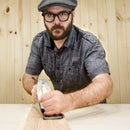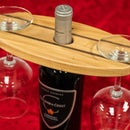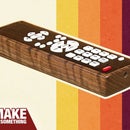Introduction: How to Make a Coffee Table With Lift Top
How to make a coffee table with a lift top mechanism and aluminum legs. The lift-top allows for bringing the table up to perfect height for dining in front of the television or bringing your laptop up to an ergonomic position. Watch the included video for an overview and be sure to subscribe to my YouTube channel for weekly videos!
Step 1: Cut Aluminum Tubing
We'll start off by making the legs out of 3/4" aluminum tubing. What I like about using aluminum is it's soft enough to cut with ordinary woodworking saw blades.
Step 2: Chamfer Aluminum Tubing Edges
I'll then chamfer the edges to allow a channel for the brazing material.
Step 3: Clean Aluminum
Before brazing it's very important that the aluminum is clean.
Step 4: Soldering the Aluminum
Clamp up the tubing and start heating the aluminum with a propane torch. Aluminum will start to melt at 1200 degrees fahrenheit but the brazing rod will melt at around 700 degrees so we want to get the aluminum hot enough to melt the rod without melting the tubing. Getting the tubing hot enough may take 4 to 5 minutes. You'll know when it's hot enough when the rod starts to melt on contact. Rub the brazing rod along the channel until it's filled in and finish it off with some more heat. If you don't get the aluminum hot enough the brazing rod will just clump up and not stick to the tubing. This takes some patience and practice as my first few tries resulted in failures and ugly joints. You'll want to repeat the process on all 4 sides of the tubing for a strong joint.
Step 5: Sand, Prime and Paint
Then I'll sand, primer and paint my legs flat black.
Step 6: Cut Plywood to Size
Cut all your plywood pieces to width and length.
Step 7: Crosscutting Plywood Without Tear-out
Crosscutting plywood with a combination blade almost always results in tear out and I find the easiest way to prevent that is to just cover the plywood with painters tape.
Step 8: Rip Thin Strips for Edge Banding
To cover up the exposed edges of the plywood I have some 1/16th inch thick walnut that I'll rip into 3/4 inch strips. You could also use a 3/4" thick walnut board and rip thin strips off of that or even purchase some pre-made walnut edge banding.
Step 9: Edge Banding
Now I'll just glue it down to the exposed edges of the plywood and clamp it down with painters tape.
Step 10: Glue on Panels
On the top side I'll use painters tape to mark the inset. This will also protect the wood from glue squeeze out. I'll then add some glue to the bottom of the pieces and set them in place using the blue tape as reference.
Step 11: Add Screws for Reinforcement
Let that sit and dry for a bit, flip it over and add some screws for reinforcement. Glueing it before adding the screws allows for perfect placement.
Step 12: Add Corner Accents
I'll then add some corner accents buy just gluing and taping them in place.
Step 13: Screw on Legs
For the legs I'll just drill holes and screw it in place. I'm using 1 1/4 inch pocket hole screws because of their large head.
Step 14: Screw on Rockler Lift-top Mechanism
For the Rockler lift mechanism I'll just set it inside and use the same screws to secure it in place.
Step 15: Screw on Lift Top
The easiest way I found to attach the top is to set it in place and slowly lift it up and allow the mechanism to raise with it. Make sure the wood doesn't slip, clamp it down and screw it in place.
Step 16: Finish With Boiled Linseed Oil and Polyurethane
I'll then take it all apart and and finish the wood with boiled linseed oil and a few coats of polyurethane.
Step 17: Rubber Feet and Bumpers
Put it all back together, add some rubber feet and some rubber bumpers and that's it!
Step 18: All Done!!
And that's it! You can find more details as well as plans for this project on my website. Let me know what you think in the comments below. I'll also do my best to answer any questions you have. Now go make something!













